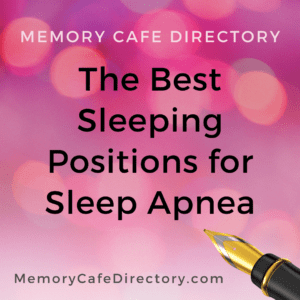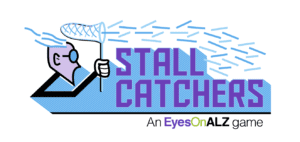Memory Cafe Directory posts and/or links to retailers can be advertising, sponsored, or affiliate links. We may earn a small commission from them. Thank you.
At first glance, seeing an article about the best sleeping positions for sleep apnea might not be of interest to the dementia caregiving community. The reality is that sleep apnea is a fairly common disorder and may affect a person living with dementia or their care partners.
Sleep Quality: Important for All
There are many factors that can impact our sleep quality. They range from Gastroesophageal Reflux Disease (Acid Reflux) to pregnant women in their third trimesters, to many other general health conditions. As you can see, it can be hard to get a good night’s sleep.
Many Sleep Apnea treatments are available to address these challenges. However, it may make sense to fully understand it before we address it by discussing the best sleeping positions for sleep apnea.
What is Sleep Apnea?
Sleep apnea is a common sleep disorder that causes a person to stop breathing for short periods of time during sleep. These pauses in breathing can last from a few seconds to minutes, and they can occur multiple times throughout the night.
This can lead to a variety of health problems, including high blood pressure, heart disease, and stroke long term. It could simply have an impact on our memory.
There are two main types of sleep apnea:
- Obstructive Sleep Apnea (OSA)
- Central Sleep Apnea (CSA)
OSA is the most common type and occurs when the airway becomes blocked. CSA, on the other hand, occurs when the brain fails to send the proper signals to the muscles that control breathing.
Obstructive Sleep Apnea can happen when the soft tissue muscles in the back of your throat relax. When the throat muscles relax, the airway gets so narrow (or closes) that you can stop breathing for a moment. The National Library of Medicine says ” Obstructive sleep apnea increases the risk of heart failure by 140%, the risk of stroke by 60%, and the risk of coronary heart disease by 30%.”
How Do You Know If You Have Sleep Apnea?
Testing for sleep apnea used to typically be done in a sleep lab, where a person’s sleep patterns and breathing are monitored overnight. This can be done in a hospital or at a specialized sleep center.
A test called a polysomnogram (PSG) is used to diagnose sleep apnea. This test measures brain waves, the oxygen level in the blood, heart rate, and breathing, among other things.
However, more recent developments in this space have allowed sleep apnea tests at home. This has been a game changer and has made diagnosis much easier and more convenient.
One such test that’s revolutionizing this space is called the Watchpat. This is a small device that is worn on the wrist like a watch. It detects changes in breathing, oxygen levels and other metrics to help determine whether or not an individual has sleep apnea and also the severity of the disease.
If you think you may have sleep apnea, it’s important to see a doctor for a proper diagnosis and treatment. Left untreated, sleep apnea can lead to a variety of serious health problems. Making lifestyle changes and possibly CPAP therapy (more on that in a moment) can help to improve symptoms and protect your overall health.
What Are The Symptoms of Sleep Apnea?
Symptoms of sleep apnea include loud snoring, pauses in breathing during sleep, and feeling tired even after a full night’s sleep. It’s important to note that not everyone who snores has sleep apnea, and not everyone with sleep apnea snores.
However, if you have any of these symptoms, it’s important to see a doctor for a proper diagnosis.
The health effects of sleep apnea can be serious and may include high blood pressure, heart disease, stroke, and diabetes. Sleep apnea can also increase the risk of accidents, as it can cause daytime sleepiness and impaired concentration.
Obesity – A Major Risk Factor for Sleep Apnea
Obesity increases the risk of sleep apnea because excess body fat can cause the airway to become narrowed, making it more likely for the airway to become blocked during sleep. Obesity can also cause changes in the brain that can affect the signals that control breathing.
In addition to increasing the risk of sleep apnea, obesity can also make sleep apnea worse. People who are obese are more likely to have severe sleep apnea, and they may have more difficulty using treatment options such as continuous positive airway pressure, also known as a CPAP Machine.
What Are the Treatments for Sleep Apnea?
Treatment for sleep apnea typically involves using a continuous positive airway pressure (CPAP) machine. This machine delivers a constant flow of air through a mask that is worn during sleep. The air pressure helps to keep the airway open, allowing the person to breathe properly.
Other treatment options include oral appliances, which are worn in the mouth to help keep the airway open, and surgery to remove excess tissue in the throat that may be blocking the airway.
In addition to these treatments, making lifestyle changes can also help to improve symptoms of sleep apnea. These changes may include losing weight, quitting smoking, and avoiding alcohol and sedatives.
Tips for Improving Sleep
There are several steps you can take to improve your sleep and get a better night’s rest, whether you think you have a sleep disorder or not. Some tips for improving sleep include:
• Maintain a regular sleep schedule. Going to bed and waking up at the same time each day can help to regulate your body’s sleep-wake cycle and improve the quality of your sleep.
• Create a relaxing bedtime routine. Developing a relaxing bedtime routine can help to prepare your body and mind for sleep. This may include activities such as taking a warm bath or shower, reading a book, or listening to calming music.
• Create a comfortable sleep environment. Your sleep environment can have a big impact on the quality of your sleep. Make sure your bedroom is cool, dark, and quiet, and that your bed is comfortable and supportive.
• Avoid caffeine, alcohol, and nicotine. Caffeine, alcohol, and nicotine can all interfere with your ability to fall asleep and stay asleep. Avoid consuming these substances, especially in the hours leading up to bedtime.
• Exercise regularly. Regular physical activity can help to improve your sleep. However, avoid exercising too close to bedtime, as this can actually make it harder to fall asleep.
• Reduce stress. Stress and anxiety can interfere with sleep. Try to reduce stress in your life through relaxation techniques, such as deep breathing or meditation.
By following these tips, you can improve your sleep and get the restful, restorative sleep your body needs. Getting enough quality sleep is essential for good health, so it’s important to make sleep a priority.
Best Sleeping Positions for Sleep Apnea
Now that we know all about Sleep Apnea and we’ve learned some tips to get better sleep, let’s explore the best sleeping positions for Sleep Apnea.
We all have a preferred sleeping position. Some prefer the right side, another person might be a stomach sleeper, still others prefer the fetal position. There’s event the strategy of using an extra pillow.
Although we may have a favorite sleeping position, there is not one best sleep position. However, there are ones that are better than others. Spoiler Alert: Side sleepers often do much better than back sleepers!
Side Sleepers
Many believe side sleeping is the best position for those with Sleep Apnea. In fact, sleeping our our left side is even better than the right! It contributes to better blood flow and can help reduce acid reflux. With a good pillow, it can help to reduce neck pain and can help keep the spin in good alignment.
Stomach Sleepers
Gravity becomes an ally for stomach sleeping. That soft tissue described above is encouraged to move forward when sleeping in the prone position. This can help lower the chance of the airway closing.
Body position is important here. Be sure to use a thin pillow designed for stomach sleepers, or you may inadvertently introduce air blockages to your mouth or nose and cause an airway obstruction.
A Worst Position for Quality of Sleep?
Back Sleepers
Yes, the worst sleeping position is on our backs. Just as gravity is the friend of stomach sleepers, it is the enemy of back sleepers. Although it can allow for less fighting with the CPAP mask and hose, gravity pulls that soft tissue to the back of the throat. This supine position really isn’t a good idea when sleep apnea patients already have challenges getting enough oxygen.
One common (and “age-old”) strategy people have employed to prevent staying on your back while sleeping is to sew a couple of tennis balls into the back of your night shirt. It sounds odd, but sometimes simpler approaches to sleep medicine pay dividends.
Give it a try – you may just get some restful sleep!
Better Sleep for Better Quality of Life
Sleep apnea symptoms can be your cue to try different sleeping positions to help address your breathing problems while sleeping. There are not best sleeping positions for sleep apnea for everyone. If one doesn’t work for you, try a new position. It is worth experimenting for better health benefits.
Experimenting on your own can’t hurt, but don’t underestimate the value of seeing a sleep specialist. They may recommend a sleep study in addition to discussing the right sleeping position for you.






